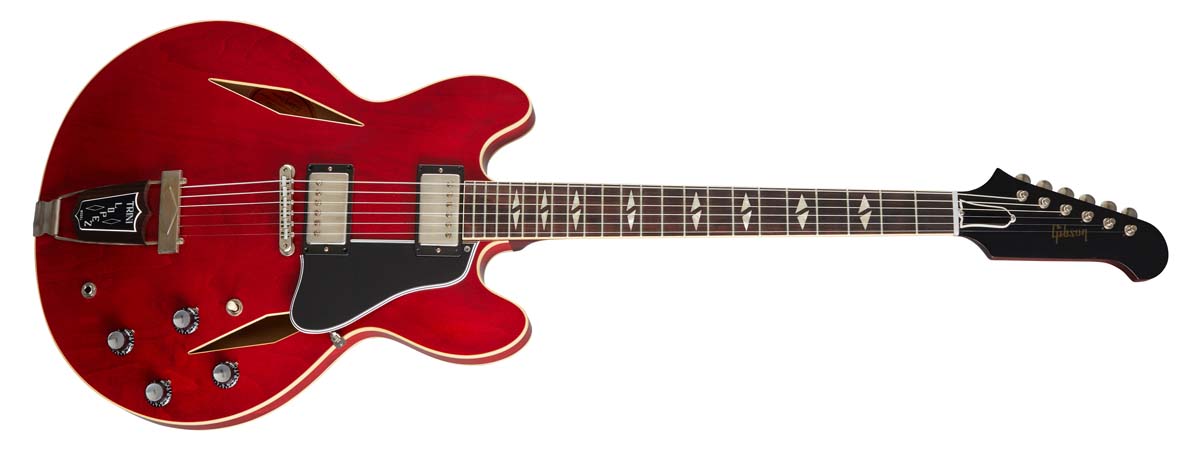Classic gear: Gibson Trini Lopez Standard
The story of the classic signature model that offered a new twist on Gibson's semi-hollow designs

In August this year, Mexican-American guitar legend Trini Lopez – the man once hailed by Gibson as “probably the most exciting young star in the music business” – sadly passed away at the age of 83 after contracting COVID-19.
Born Trinidad Lopez III and hailing from Texas, Trini formed his first band as a teenager and began his recording career in his early 20s. Having eventually scored a residency at PJ’s nightclub in Los Angeles, he was promptly scouted by Frank Sinatra for his new label, Reprise Records.
The Top 10 debut live album Trini Lopez At PJ’s soon followed in ’63, spawning a smash hit single, If I Had a Hammer, and with Trini pictured on the LP cover cradling his beloved Gibson Barney Kessel Regular model, it wasn’t too long before Gibson began hammering on his door for a signature guitar of his own.

In the early 60s while Gibson’s premier solidbody electrics, the Les Paul line, completed their transition to the thin-bodied, double Florentine cutaway design and non-signature/SG designation, the company sought to fill its artist endorsement void with several new models. With electric jazz guitar in its heyday, three of the scene’s hottest players collaborated with Gibson to produce a series of electric archtops.
Subsequently, the Barney Kessel Custom, Barney Kessel Regular and Johnny Smith were launched in ’61, followed by the Tal Farlow in ’62 and the Johnny Smith Double in ’63. Along with the release of the Gibson Everly Brothers flat-top in ’62, and Epiphone Al Caiola and Howard Roberts signature guitars in ’63 and ’64 respectively, Gibson’s Kalamazoo plant boasted an impressive array of new artist models.

Hoping to bolster this line-up with a young, popular rising star, Gibson approached Trini Lopez in ’64, developing two unique signature models later that year. He had already established a strong association with the Barney Kessel Regular, so Trini’s personal spin on this deep-bodied, double Florentine cutaway electric archtop came in the form of the Trini Lopez Deluxe.
1958
ES-335 released
Late 1964
First production models; 1 11/16” nut; nickel-plated hardware; Cherry finish
1965
T-top humbuckers; nut width decreases; chrome-plated hardware; c. 320 shipped
1966
Sparkling Burgundy and Cherry finishes; c. 485 shipped
1967
‘Bonnet’ knobs change to ‘witch hat’ knobs; c. 785 shipped
1968
c. 240 shipped
1969
c. 110 shipped
1970
Discontinued; c. 25 shipped
2009
Custom Shop reissue; limited run; trapeze or stop tailpiece; Antique Faded Red finish
2019
1964 Trini Lopez Standard Reissue (Artist Collection)
Additionally, in order to capture some of the less traditional end of the market and capitalise on the success of the company’s double-cutaway thinline semis – a revolutionary design concept introduced in ’58 with release of the ES-335T – the Trini Lopez Standard was added to the line. The very first samples of both models were shipped in late ’64, with production beginning in earnest the following year.
All the latest guitar news, interviews, lessons, reviews, deals and more, direct to your inbox!
Both the Trini Lopez Deluxe and Standard models are easily identified by their diamond-shaped soundholes (in place of regular f-holes) and fretboard inlays.
Both models can be further distinguished by their Fender-like asymmetrical headstocks with all six tuners in a line across the bass side – a feature common to the ‘non-reverse’ Firebird range, also announced in ’65.
The Deluxe is the rarer of the two Trini Lopez models with around 300 shipped in total, whereas the Standard model proved considerably more popular with nearly 2,000 guitars being shipped between 1964 and 1970, when both instruments were discontinued.
Trini was still a highly active musician in later life, appearing on stage at the NAMM Show only last year to talk about his life in music and the release of his new Gibson signature model.
The 1964 Trini Lopez Standard Reissue is currently available from Gibson’s Artist Collection.
Rod Brakes is a music journalist with an expertise in guitars. Having spent many years at the coalface as a guitar dealer and tech, Rod's more recent work as a writer covering artists, industry pros and gear includes contributions for leading publications and websites such as Guitarist, Total Guitar, Guitar World, Guitar Player and MusicRadar in addition to specialist music books, blogs and social media. He is also a lifelong musician.

